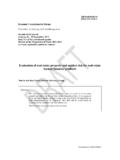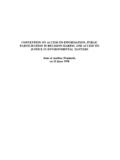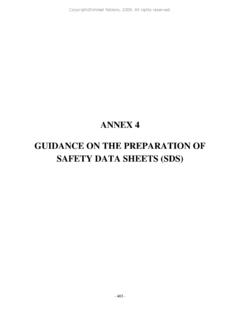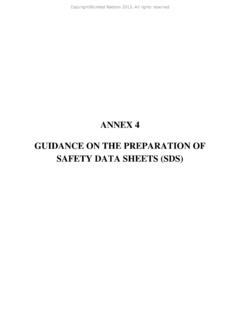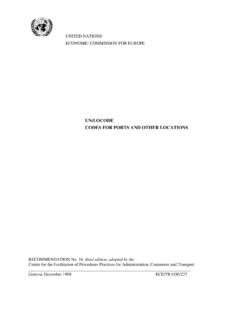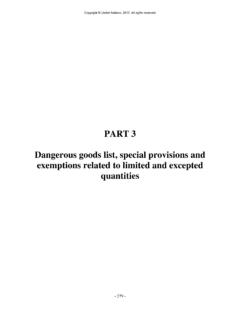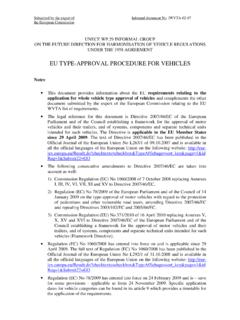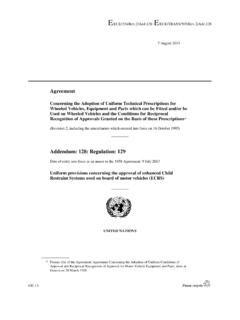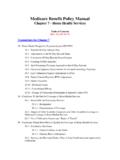Transcription of GLOBALLY HARMONIZED SYSTEM OF CLASSIFICATION …
1 ST/ GLOBALLY HARMONIZED SYSTEM OF CLASSIFICATION AND LABELLING OF CHEMICALS (GHS) Fourth revised edition UNITED NATIONS New York and Geneva, 2011 Copyright@United Nations, 2011. All rights The designations employed and the presentation of the material in this publication do not imply the expression of any opinion whatsoever on the part of the Secretariat of the United Nations concerning the legal status of any country, territory, city or area, or of its authorities, or concerning the delimitation of its frontiers or boundaries. Copyright United Nations, 2011 All rights reserved.
2 No part of this publication may, for sales purposes, be reproduced, stored in a retrieval SYSTEM or transmitted in any form or by any means, electronic, electrostatic, magnetic tape, mechanical, photocopying or otherwise, without prior permission in writing from the United Nations. UNITED NATIONS Sales No. ISBNNo. 978- 92-1-117042-9 eISBN No. 978-92-1-054745-1 ST/ Copyright@United Nations, 2011. All rights iii - FOREWORD 1. The GLOBALLY HARMONIZED SYSTEM of CLASSIFICATION and Labelling of Chemicals (GHS) is the culmination of more than a decade of work. There were many individuals involved, from a multitude of countries, international organizations, and stakeholder organizations.
3 Their work spanned a wide range of expertise, from toxicology to fire protection, and ultimately required extensive goodwill and the willingness to compromise, in order to achieve this SYSTEM . 2. The work began with the premise that existing systems should be HARMONIZED in order to develop a single, GLOBALLY HARMONIZED SYSTEM to address CLASSIFICATION of chemicals, labels, and safety data sheets. This was not a totally novel concept since harmonization of CLASSIFICATION and labelling was already largely in place for physical hazards and acute toxicity in the transport sector, based on the work of the United Nations Economic and Social Council's Committee of Experts on the Transport of Dangerous Goods (UNCEDTG).
4 Harmonization had not been achieved in the workplace or consumer sectors, however, and transport requirements in countries were often not HARMONIZED with those of other sectors in that country. 3. The international mandate that provided the impetus for completing this work was adopted in the 1992 United Nations Conference on Environment and Development (UNCED), as reflected in Agenda 21, : "A GLOBALLY HARMONIZED hazard CLASSIFICATION and compatible labelling SYSTEM , including material safety data sheets and easily understandable symbols, should be available, if feasible, by the year 2000". 4. The work was coordinated and managed under the auspices of the Interorganization Programme for the Sound Management of Chemicals (IOMC) Coordinating Group for the Harmonization of Chemical CLASSIFICATION Systems (CG/HCCS).
5 The technical focal points for completing the work were the International Labour Organization (ILO); the Organization for Economic Cooperation and Development (OECD); and the United Nations Economic and Social Council's Sub-Committee of Experts on the Transport of Dangerous Goods (UNSCETDG). 5. Once completed in 2001, the work was transmitted by the IOMC to the new United Nations Economic and Social Council's Sub-Committee of Experts on the GLOBALLY HARMONIZED SYSTEM of CLASSIFICATION and Labelling of Chemicals (UNSCEGHS). This Sub-Committee was established by Council's resolution 1999/65 of 26 October 1999 as a subsidiary body of the former UNCETDG, which was reconfigured and renamed at the same occasion "Committee of Experts on the Transport of Dangerous Goods and on the GLOBALLY HARMONIZED SYSTEM of CLASSIFICATION and Labelling of Chemicals" (UNCETDG/GHS).
6 The Committee and its sub-committees work on a biennium basis. The secretariat services are provided by the Transport Division of the United Nations Economic Commission for Europe (UNECE). 6. The UNSCEGHS is responsible for maintaining the GHS and promoting its implementation. It provides additional guidance as needs arise, while maintaining stability in the SYSTEM to encourage its adoption. Under its auspices, the document is regularly revised and updated to reflect national, regional and international experiences in implementing requirements into national, regional and international laws, as well as experiences of those doing the CLASSIFICATION and labelling.
7 7. The first task of the UNSCEGHS was to make the GHS available for worldwide use and application. The first version of the document, which was intended to serve as the initial basis for the global implementation of the SYSTEM , was approved by the Committee of Experts at its first session (11-13 December 2002) and published in 2003 under the symbol ST/ Since then, the GHS has been updated every two years as needs arise and experience is gained with its implementation. 8. The first revised edition (published in 2005) included new provisions for aspiration hazards, and guidance on the use of precautionary statements and pictograms and on the preparation of Safety Data Sheets (SDS s).
8 The second revised edition (published in 2007) included new and revised provisions concerning, inter alia, the CLASSIFICATION and labelling of explosives; respiratory and skin sensitizers; toxic by inhalation Copyright@United Nations, 2011. All rights iv - gases and gas mixtures; additional guidance on the interpretation of the building block approach and on the evaluation of the carcinogenic potential of chemicals; and the codification of hazard and precautionary statements ( H and P codes). The third revised edition (published in 2009) introduced new provisions for the allocation of hazard statements and for the labelling of small packagings; two new sub-categories for respiratory and skin sensitization; the revision of the CLASSIFICATION criteria for long-term hazards (chronic toxicity) to the aquatic environment; and a new hazard class for substances and mixtures hazardous to the ozone layer.
9 9. At its fifth session (10 December 2010) the Committee of Experts adopted a set of amendments to the third revised edition of the GHS which were consolidated in document ST/ The fourth revised edition of the GHS takes account of these amendments which concern: new hazard categories for chemically unstable gases and non-flammable aerosols; further rationalization of precautionary statements, and further clarification of some of the criteria to avoid differences in their interpretation. 10. In paragraph 23 (c) of its Plan of Implementation adopted in Johannesburg on 4 September 2002, the World Summit on Sustainable Development (WSSD) encouraged countries to implement the GHS as soon as possible with a view to having the SYSTEM fully operational by 2008.
10 Subsequently, in its resolutions 2003/64 of 25 July 2003, 2005/53 of 27 July 2005, 2007/6 of 23 July 2007 and 2009/19 of 29 July 2009, the United Nations Economic and Social Council invited Governments who had not yet done so, to take the necessary steps, through appropriate national procedures and/or legislation, to implement the GHS as recommended in the WSSD Plan of Implementation. It also reiterated its invitation to the regional commissions, United Nations programmes, specialized agencies and other organizations concerned, to promote the implementation of the GHS and, where relevant, to amend their respective legal international instruments addressing transport safety, workplace safety, consumer protection or the protection of the environment so as to give effect to the GHS through such instruments.
